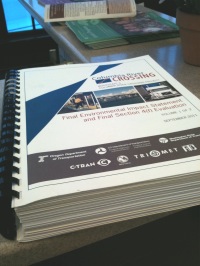
at locations throughout Portland.
(Photo © J. Maus)
It’s been several months since I last chimed in on the Columbia River Crossing (CRC) project.
Somehow, despite many lingering questions — especially around its funding plan — the $3.5 billion project which has been a roller-coaster of controversy and stops and starts over last several years — seems to have gained a bit of momentum. Or, as noted local architecture critic Brian Libby puts it, the “Frankenstein lurches closer to life.”
On September 8th, Metro council (led by ardent CRC supporter Tom Hughes) voted 5-0 in support of the CRC’s Final Environmental Impact Statement (FEIS). To give you an idea of the importance and context of that vote, here’s a snip of reporting on it from The Columbian:
“The agency is the last of the six local entities that must approve the CRC’s Final Environmental Impact Statement; the move means the document will now go to the federal government for approval.
If it passes federal muster — which planners hope will happen by December — the CRC then can begin seeking funding for its $3.1 billion to $3.5 billion bridge, highway and light rail project on Interstate 5…
Project critics had been hoping Metro’s concerns would cause them to block the FEIS from going forward.
But Metro President Tom Hughes said the CRC had addressed enough of their worries that they were comfortable giving it the go-ahead… “I think that we’re ready to go,” Hughes said. “This project has to happen…”
Down in Salem, the newly formed Legislative Oversight on Columbia River Crossing committee had its first meeting today. ODOT Director Matt Garrett and CRC project staff gave lawmakers a progress report on the project. The committee is made up of 10 state lawmakers (four in the Senate and six in the House) including Senator Ginny Burdick (D-Portland) and House Rep (and Co-Chair) Tobias Read (D-Beaverton). Many project watchers hope key questions about the project can be raised and vetted in that committee.
With its clear sense of momentum, activists who oppose the project have begun to wonder how best to move forward. At this point, there doesn’t seem to be a cohesive, coordinated effort to stop the project. Instead, there are several individuals (like economist Joe Cortright and a smattering of neighborhood activists) who continue to show up and make passionate speeches against it; but given the political muscle behind this project, it will take much more than that to stop it.
Grassroots group Stop The CRC, hasn’t been active all year. At this point, Coalition for Livable Future seems to be the main opposition.
For a project of this size, and for one that’s likely to have huge impacts on our community and our pocketbooks, the relative silence of opposition groups is quite surprising.
On the political side of things, there’s a sense that some new blood in key seats might help stymie the project (or at least improve it significantly). Bob Stacey, who narrowly lost the Metro president spot to Hughes, is running again — this time for the District 6 councilor position.
Stacey has endeared himself to anti-CRC activists for his opposition to the project and his proposed solutions.
Another political bright spot for those who want a different outcome with this project are candidates in the race to replace Portland Mayor Sam Adams.
Jefferson Smith is firmly opposed to the project. “It’s no secret that I have been a critic of the Columbia River Crossing,” Smith writes on his campaign website, “Going forward, we need projects that match our values and that we can afford.”
Joining Smith in opposition to the project is Charlie Hales, who told the Willamette Week back in June that he wouldn’t support the project in its current form.
Eileen Brady, the other mayoral front-runner, has expressed mixed feelings about the project; but hasn’t come out clearly against it yet.
As for bicycle elements of the project, the CRC’s Bicycle and Pedestrian Advisory Committee met only once in the past year. Back in July, a planner from PBOT who’s working with ODOT on the project said they’re spending about $10 million on new bikeways.
According to chapter two of the FEIS, that money will pay for:
“… new facilities such as the multi-use pathway across the Columbia River and connections to existing and future pathways, street improvements around the rebuilt interchanges, and new facilities for bicyclists and pedestrians around the new light rail stations and park and rides.”
The latest plans for bikeways on the bridge are to have a bike lane on the west side of the local bridge to Hayden Island and a 16-foot wide shared-use path on the east side.
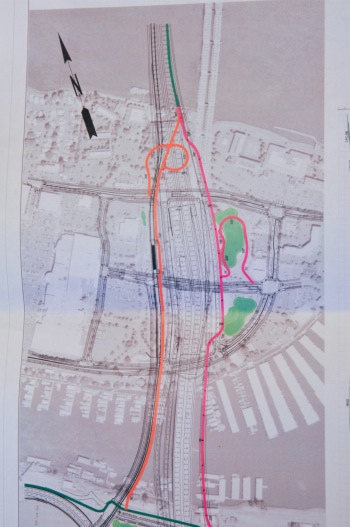
I’ll try to delve into more bike elements of the project in the coming days.
How are you feeling about the CRC project?
— For a great roundup of news coverage over the past few months, check out this post on BlueOregon by Evan Manvel.


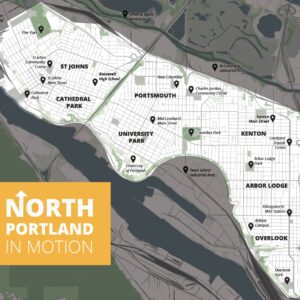
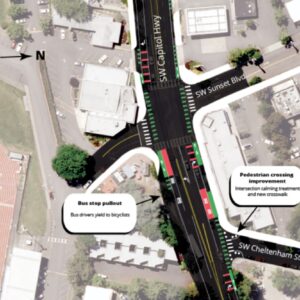
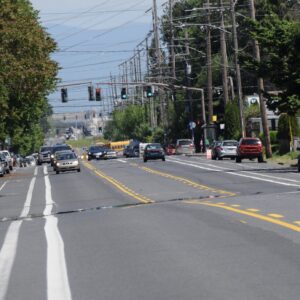
Thanks for reading.
BikePortland has served this community with independent community journalism since 2005. We rely on subscriptions from readers like you to survive. Your financial support is vital in keeping this valuable resource alive and well.
Please subscribe today to strengthen and expand our work.
A big “NO” to the CRC from me.
Jonathan-
the facebook ‘permalink’ isn’t very permanent for me
Thanks for the much needed update Jonathan! Too bad the Metro election isn’t until June and the mayoral election is over a year away. I wonder if we could tie in gentrification with the project, that might slow things down.
Thanks for the update. A group of activists will host a pubic CRC debate soon. The audience will have beer and input in the debate. A team of six will speak in favor of the Common Sense Alternative. Will anyone show up to argue in favor of the CRC? We might just have to invite the media to take photos of the six empty seats.
Here is one reason why the CRC opposition has failed. The CLF staff showed up to a bit no on the CRC Rally. Many individuals divided up the chores. The CLF passed out clipboards, then refused to send email to the members about other protests, refused to invite the list to join other groups who oppose the CRC. It’s insider politics in Portland.
I am confused at what you are saying. Can you please clarify?
This is language that always raises my hackles:
Hughes said. “This project has to happen…”
Oh, really?
Still hugely opposed.
Amazing that in this day and age, projects like this are still moving forward.
It is, um, starkly dumbfounding as to how different folks interpret the same CRC facts … benefits/costs … relative to their take on the future … eh 9watts??
Yeah, I get the impression that the boosters (and that is what they are, note Hughes’ language) aren’t so terribly concerned with facts, costs, toll revenue projections, etc. They know this represents progress, jobs for their contractor friends, smart politics, whatever, and that is enough for them.
The rest of us who may be more or less opposed or perhaps even ignorant of the details are going to foot the bill not just through taxes before, during, and after, but we’ll end up with a big hunk of concrete that no one will want, or know what to do with in a few short years. These are commonly called stranded assets. Germany and Japan–now–want out of nuclear power. Good for them. But guess who paid for all those damn plants over the past two generations, and is going to pay to have them decommissioned and the waste disposed of and stored for the next 10,000 years. Yep. Taxpayers.
Same here. More concrete that will soon enough become a liability. I give it ten years, fifteen max, and we’re all going to look at this huge piece of flat bridge like the Japanese are now looking at their fleet of nuclear plants and wish they’d spent all those quadrillions on something that they could now use/that they desperately need.
+1
There is nothing wrong with the current bridges. Straighten the washington side approach. Get rid of the poor exit and entrance ramps = No more bottleneck. And put a nice local bridge to hayden island, so I and others can actually go shopping there either without getting on freeway or by bicycle.
I see that a presentation of the Common Sense Alternative made it to the Oregon Legislature for review, but they no longer have it on their website (404 Not Found). Between that and the wording in the Columbian, it sounds to me like the CRC is again/still being played as a done deal by the powers that be, as it was when BTA stomped off. It will take a very concerted effort with very politically savvy leadership to salvage even a shred of hope for what to me is an obviously better plan.
Thanks for the coverage, Maus, please keep at it.
More highway= more divided neighborhoods…
More lanes= more cars= more climate change.
Our region doesn’t have the highways that Dallas, LA, etc have. We like it this way. I want 20 minute walking neighborhoods and breathable air, not endless suburban sprawl.
How much less would it cost without light rail??? The people in washington have made it clear that they dont want light rail, yet it is being forced down their throats anyways. It’s too bad Oregon spent all this money building a rail system going to the boarder without having any concrete plans for it continuing across. Right now we have a train to nowhere, How many of us really need to get to the not so important EXPO center?
Hi Jim,
You should check out the park and ride at Delta Park. It’s full most days. You could also check out how full the Yellow Line cars are. Pretty impressive really. I know that if I want to get downtown and have some elbow room that I need to catch an earlier train then neccessary to reach my destination. The Yellow Line is hardly a “train to nowhere”.
That said, I have no desire to help pay for light rail to Clark County. They don’t seem to want it.
Park and ride is great. Why dont they just get on buses instead of zillion dollar trains?
Now you’re just changing your argument Jim. I don’t like to play that game. But regarding your question: I don’t know why light rail instead of buses. But from your question, i take that you would like to better understand the pros and cons of both modes. Me too. I think that I’ll look it up. I suggest you do the same.
Back-of-the-envelope, the costs are roughly 50% highway expansion and new interchanges, 25% new bridge, and 25% light rail. Hence it’s not really a bridge project or a light rail project, it’s a highway expansion project. Most of the costs aren’t about crossing the river, which is why I call it the CRC highway megaproject rather than the Columbia River Crossing.
As far as how much it will cost, ODOT has a horrible recent record on predicting project costs, 90% of megaprojects go over budget, and it depends on whether you count interest costs, etc. So, the total cost is somewhere between $3.2 and $8.6+ billion dollars, a quarter of which might be cut if light rail were cut from the project.
Read more about cost problems and megaprojects and the CRC here:
http://www.blueoregon.com/2011/03/costly-risks-crc/
Joe —
Was this the April 2009 “Stop the CRC Rally” held at Waterfront Park?
* http://bikeportland.org/2009/03/02/crc-rally-planned-for-april-commissioner-fritz-will-attend-15577
* http://bikeportland.org/2009/04/05/crc-rally-slideshow-and-open-thread-16782
Cosponsored by the BTA, Coalition for Livable Futures (CLF) and others?
And volunteers passed out clipboards to get everyone’s email address for future networking and rallying.
Then, the CLF collected the clipboards, brought them back to their office, and the email addresses were never used by the CLF nor released to the cosponsoring organizations?
That’s the story I’ve heard, it sounds like that is what you’re referring to.
If this story is accurate, it is a sure way to take the wind out of the sails of a grassroots movement…
Ted Buehler
Mara from CLF here. CLF shared the list with multiple partners at the time of the rally, but did not share with individual activists in order to protect the privacy of people’s emails. CLF has continued to post action alerts and information about CRC activities, including from other organizations and grassroots groups like Stop the CRC.
CLF, along with many others, continues to be active on the CRC highway mega-project. We are co-petitioners with Northeast Coalition of Neighborhoods on a challenge to CRC’s Land Use Final Order, are working with an attorney on comments on the Final Environmental Impact Statement, and has been active at governments including Metro and the Oregon legislature. We are excited about the opportunity to work with more grassroots activists, and as always want to coordinate with people and groups who are looking for ways to engage.
Speaking of opportunities for activism, CRC is looking for members for a bi-state citizen advisory committee. Anyone interested? I’ll be interested to learn if anyone with concerns about the project is selected. Details are in a news story in the Columbian: http://www.columbian.com/news/2011/sep/17/columbia-river-crossing-advisory/
I should be on one of these citizen groups but I know I couldn’t stomach working for the CRC. If the groups are to coordinate and work out issues with neighbors, it would be in support of the CRC. I just don’t see how an adversary would function here.
A description of the facility improvements for bicyclists and pedestrians for the CRC project can be found at:
http://columbiarivercrossing.org/FileLibrary/FactSheets/CRC_Ped_Bike_Folio.pdf
Yeah, that gentrification thing seems to work pretty well.
Years ago I-5 TF members were shown maps that indicated that the project would raise property values in Clark county and lower them in N. Portland. So it would shift wealth to the suburbs as freeway expansions in citys always do, which in a way will slow redevelopment, i.e. gentrification in N. Portland. Are you sure that is something you want?
I dont see how the Feds are going to kick in the 80% funding when the chairman of the Transportation and Infrastructure committee is a tea party zealot who wants to cut his budget by 1/3 next year. Likewise, neither state can afford it without tolling and we all know how Clark County people feel about paying their fair share! Math will stop the CRC
Math and reason dont fit into the equation. Politicians like these kind of projects that they can attach their names to. What are the odds that it will never get finished?
Those of you lumping all Clark County residents into a monolithic opinion, consider how you feel about all bike riders being so classified, and consider that a successful challenge to the present plans will require a coalition of a variety of dissenting views.
Seems like the most costly option is being put forward in a time when we should be more selective about our spending. Is this really the region’s priority? Perhaps a third bridge across the Columbia should be prioritized, but a massive swath of concrete over 600 feet wide seems unnecessary. As do the interchange reconstructions north of the river.
If a more appropriately-sized project could be supported with tolls only, then I’m supportive. For the few times I travel across that bridge, I’d be more than happy to fork over a $5 toll to avoid the traffic.
Data has never ruled this process. If a third of the trips are local, why not a local or arterial bridge. Tolls would fix it this afternoon!
As far as the “math with stop the CRC” angle, isn’t there some credibility to this? Doesn’t the Treasurer’s report clearly lay out the major issues with funding this project? If OR-WA have to secure massive federal support, which theoretically will go through a tighter screen in the future, I would hope there would be some major questions about the wildly off tolling estimates and their impact on financing what will likely be a $5+ billion project.
As a side note, watched the video on the Common Sense Alternative the other day and was seriously impressed. Does anyone know anything approaching this was analyzed in the Draft Environmental Impact Statement?
Eileen Brady supports the CRC according to an article in last week’s Portland Tribune.
After reading about the state of the world’s forests on the front page of last Wednesday’s NYTimes, I don’t know how leaders, or anyone, with a conscience could support the CRC. The DOTs are backwards thinking.
Hear, hear!, or, as I’ve started seeing people write, here, here!